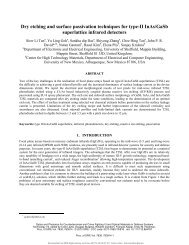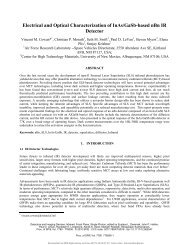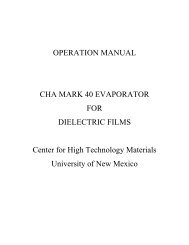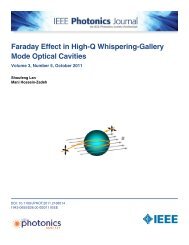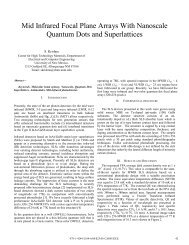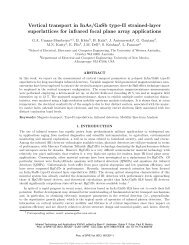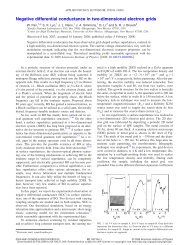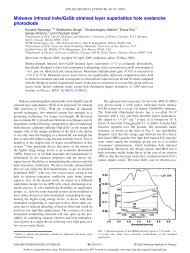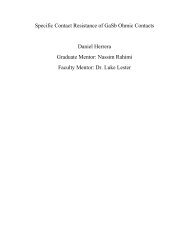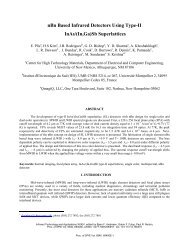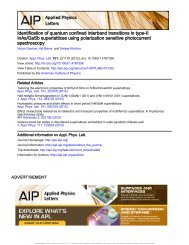Rapid degradation of CdSe/ZnS colloidal quantum dots exposed to ...
Rapid degradation of CdSe/ZnS colloidal quantum dots exposed to ...
Rapid degradation of CdSe/ZnS colloidal quantum dots exposed to ...
Create successful ePaper yourself
Turn your PDF publications into a flip-book with our unique Google optimized e-Paper software.
APPLIED PHYSICS LETTERS 93, 173101 2008<br />
<strong>Rapid</strong> <strong>degradation</strong> <strong>of</strong> <strong>CdSe</strong>/<strong>ZnS</strong> <strong>colloidal</strong> <strong>quantum</strong> <strong>dots</strong> <strong>exposed</strong><br />
<strong>to</strong> gamma irradiation<br />
Nathan J. Withers, 1 Krishnaprasad Sankar, 1 Brian A. Akins, 1 Tosifa A. Memon, 1<br />
Tingyi Gu, 1,a Jiangjiang Gu, 1,a Gennady A. Smolyakov, 1 Melisa R. Greenberg, 1,b<br />
Timothy J. Boyle, 2 and Marek Osiński 1,c<br />
1 Center for High Technology Materials, University <strong>of</strong> New Mexico, 1313 Goddard SE, Albuquerque,<br />
New Mexico 87106-4343, USA<br />
2 Advanced Materials Labora<strong>to</strong>ry, Sandia National Labora<strong>to</strong>ries, 1001 University Blvd. SE, Albuquerque,<br />
New Mexico 87106, USA<br />
Received 29 March 2008; accepted 2 July 2008; published online 28 Oc<strong>to</strong>ber 2008<br />
Effects <strong>of</strong><br />
137 Cs gamma irradiation on pho<strong>to</strong>luminescent properties <strong>of</strong> <strong>CdSe</strong>/<strong>ZnS</strong> <strong>colloidal</strong><br />
<strong>quantum</strong> <strong>dots</strong> are reported. Optical <strong>degradation</strong> is evaluated by tracking the dependence <strong>of</strong><br />
pho<strong>to</strong>luminescence intensity on irradiation dose. <strong>CdSe</strong>/<strong>ZnS</strong> <strong>quantum</strong> <strong>dots</strong> show poor radiation<br />
hardness, and severely degrade after less than 20 kR exposure <strong>to</strong> 662 keV gamma pho<strong>to</strong>ns. © 2008<br />
American Institute <strong>of</strong> Physics. DOI: 10.1063/1.2978073<br />
Colloidal <strong>quantum</strong> <strong>dots</strong> QDs have attracted tremendous<br />
interest over the last few years for a large variety <strong>of</strong> applications<br />
ranging from op<strong>to</strong>electronic through pho<strong>to</strong>catalytic <strong>to</strong><br />
biomedical, including applications as nanophosphors in<br />
light emitting diodes LEDs. 1 For example, red and green<br />
<strong>CdSe</strong>/<strong>ZnS</strong> QDs have been used as phosphors in white LEDs<br />
based on blue-emitting InGaN-based chips. 2 <strong>CdSe</strong>/<strong>ZnS</strong> QDs<br />
have also been suggested as scintilla<strong>to</strong>rs for detection <strong>of</strong> alpha<br />
particles and gamma rays. 3,4 For applications that involve<br />
exposure <strong>of</strong> light sources <strong>to</strong> ionizing radiation, it is<br />
important <strong>to</strong> know the levels <strong>of</strong> irradiation that would degrade<br />
their optical properties. In this paper, we report on the<br />
effects <strong>of</strong> gamma irradiation on pho<strong>to</strong>luminescent properties<br />
<strong>of</strong> <strong>CdSe</strong>/<strong>ZnS</strong> QDs.<br />
<strong>CdSe</strong> cores were synthesized according <strong>to</strong> a modified<br />
procedure <strong>of</strong> Aldana et al. 5 First, the cadmium precursor<br />
cadmium acetate was dissolved in a coordinating solvent,<br />
trioctylphosphine oxide TOPO. The solution was heated in<br />
a flask under controlled argon atmosphere <strong>to</strong> 325 °C, while a<br />
solution <strong>of</strong> selenium in trioctylphosphine TOP and <strong>to</strong>luene<br />
was prepared in an argon-filled glovebox with 0.1 ppm <strong>of</strong><br />
water vapor and oxygen. When the temperature <strong>of</strong> the solution<br />
in the flask reached 325 °C, the selenium precursor solution<br />
was rapidly injected in<strong>to</strong> the flask. When the contents<br />
<strong>of</strong> the flask reached red color, the solution was cooled <strong>to</strong><br />
room temperature by removing the heat source. <strong>CdSe</strong> cores<br />
were precipitated in a centrifuge using ace<strong>to</strong>ne and methanol,<br />
and collected in hexanes. For <strong>ZnS</strong> coating, the zinc precursor<br />
was prepared by dissolving the zinc alkyl alkoxide with oleic<br />
acid and octadecene, while the sulfur precursor was prepared<br />
by dissolving sulfur in octadecene. Both precursors were<br />
heated <strong>to</strong> 200–250 °C and the zinc precursor was cooled <strong>to</strong><br />
60–80 °C, while the sulfur precursor was cooled <strong>to</strong> room<br />
temperature. The <strong>CdSe</strong> nanocrystals in hexanes were mixed<br />
with octadecene and octadecylamine in a flask and heated <strong>to</strong><br />
100 °C under vacuum for 30 min, and then under argon <strong>to</strong><br />
240 °C. At that point, three alternating injections <strong>of</strong> calculated<br />
amounts <strong>of</strong> zinc and sulfur precursors were made at<br />
10 min intervals. Finally the solution was cooled <strong>to</strong> room<br />
temperature, QDs were precipitated with ace<strong>to</strong>ne and methanol,<br />
and collected in hexanes.<br />
An Eberline 1000B multiple-source gamma calibra<strong>to</strong>r<br />
was used <strong>to</strong> study the effects <strong>of</strong> irradiation on <strong>CdSe</strong>/<strong>ZnS</strong><br />
QDs. In order <strong>to</strong> accelerate the <strong>degradation</strong> process, the<br />
strongest <strong>of</strong> the available sources was used, namely a 137 Cs<br />
source with the activity <strong>of</strong> 39.7 Ci, emitting 662 keV rays.<br />
Optical <strong>degradation</strong> was evaluated based on the measured<br />
dependence <strong>of</strong> room-temperature RT pho<strong>to</strong>luminescence<br />
PL intensity on the irradiation dose. Using a Horiba<br />
Jobin Yvon Fluorolog-3 spectr<strong>of</strong>luorometer, PL measurements<br />
were performed after regular weekly periods <strong>of</strong> irradiation<br />
<strong>to</strong> check if the QDs exhibited any signs <strong>of</strong> <strong>degradation</strong><br />
in their optical characteristics. In order <strong>to</strong> separate<br />
irradiation-induced phenomena from possible effects <strong>of</strong> natural<br />
<strong>degradation</strong> due, for example, <strong>to</strong> oxidative processes, the<br />
irradiated sample had a control counterpart from the same<br />
synthesis batch that was not subjected <strong>to</strong> irradiation. Assuming<br />
that both the irradiated and control samples s<strong>to</strong>red at RT<br />
underwent the same natural aging processes and reacted <strong>to</strong><br />
environmental changes in the same way, we corrected the<br />
results <strong>of</strong> PL <strong>degradation</strong> measurements <strong>of</strong> the irradiated<br />
sample for any changes in PL intensity <strong>of</strong> the control sample<br />
with respect <strong>to</strong> its baseline measurement performed prior <strong>to</strong><br />
irradiation.<br />
The PL lifetime measurements were taken on the same<br />
spectr<strong>of</strong>luorometer in a different configuration, allowing for<br />
time-correlated single pho<strong>to</strong>n counting. Using a 375 nm<br />
pulsed diode laser source, the resolution <strong>of</strong> lifetime measurements<br />
was 100 ps. An integrating sphere accessory on the<br />
spectr<strong>of</strong>luorometer was used <strong>to</strong> measure <strong>quantum</strong> efficiency<br />
<strong>of</strong> the sample prior <strong>to</strong> and after irradiation.<br />
Figure 1a summarizes the results <strong>of</strong> the irradiation testing.<br />
The PL intensity was taken at the peak <strong>of</strong> PL emission,<br />
which shifted slightly <strong>to</strong>ward shorter wavelengths with increasing<br />
dose. <strong>CdSe</strong>/<strong>ZnS</strong> QDs, initially very bright, showed<br />
a rapid loss <strong>of</strong> light output when <strong>exposed</strong> <strong>to</strong> 662 keV rays,<br />
and were removed from the experiment after 133.2 kR cua<br />
On leave from: School <strong>of</strong> Electronic, Information, and Electrical Engineering,<br />
Shanghai Jiao Tong University, China.<br />
b Present address: CVI Laser LLC, 200 Dorado SE, Albuquerque, NM<br />
87123.<br />
c Electronic mail: osinski@chtm.unm.edu.<br />
0003-6951/2008/9317/173101/3/$23.00<br />
93, 173101-1<br />
© 2008 American Institute <strong>of</strong> Physics<br />
Author complimentary copy. Redistribution subject <strong>to</strong> AIP license or copyright, see http://apl.aip.org/apl/copyright.jsp
173101-2 Withers et al. Appl. Phys. Lett. 93, 173101 2008<br />
FIG. 2. Effects <strong>of</strong> irradiation on PL lifetimes for <strong>CdSe</strong>/<strong>ZnS</strong> QDs.<br />
FIG. 1. a Peak PL intensity in counts/second for <strong>CdSe</strong>/<strong>ZnS</strong> QDs as a<br />
function <strong>of</strong> cumulative exposure E in kiloroentgens. b Spectral changes in<br />
PL response <strong>of</strong> <strong>CdSe</strong>/<strong>ZnS</strong> QDs induced by 662 keV -ray irradiation.<br />
mulative exposure. An examination <strong>of</strong> PL spectra <strong>of</strong> these<br />
QDs revealed an irradiation-induced blueshift <strong>of</strong> the PL<br />
emission peak from the original 579 <strong>to</strong> 570 nm Fig. 1b.<br />
The <strong>CdSe</strong>/<strong>ZnS</strong> material system is known <strong>to</strong> be 12%<br />
lattice-mismatched, 6 which causes the bandgap <strong>of</strong> <strong>CdSe</strong> <strong>to</strong><br />
reduce under strain. We tentatively explain the observed<br />
blueshift in the PL emission peak by irradiation-induced defects<br />
<strong>of</strong> the QD crystalline structure that lead <strong>to</strong> partial strain<br />
relaxation.<br />
In order <strong>to</strong> enable a comparison <strong>of</strong> radiation hardness <strong>of</strong><br />
<strong>CdSe</strong>/<strong>ZnS</strong> QDs with that <strong>of</strong> other materials, the exposure in<br />
roentgens E has <strong>to</strong> be converted <strong>to</strong> an absorbed dose in rads<br />
D using the following formula valid for a monoenergetic<br />
source, 7<br />
D = 0.88E en h/ <strong>CdSe</strong> / en h/ air ,<br />
1<br />
where h is the pho<strong>to</strong>n energy and en h/ X is the<br />
mass energy-absorption coefficient for the subscripted material<br />
X. While the energy-absorption coefficient for air at<br />
662 keV is known <strong>to</strong> be 0.0293 cm 2 /g, 8 its value for <strong>CdSe</strong><br />
needs <strong>to</strong> be estimated using the constituent element data according<br />
<strong>to</strong> the following formula: 9<br />
en h/ <strong>CdSe</strong> = tr h/ Cd 1−f Cd g Cd − f Se g Se f Cd<br />
+ tr h/ Se 1−f Cd g Cd − f Se g Se f Se .<br />
2<br />
Here, tr h/ Y Y =Cd,Se is the mass energy-transfer<br />
coefficient, f Y is the weight fraction, and g Y is the average<br />
fraction <strong>of</strong> secondary-electron energy that is lost in radiative<br />
interactions. 9 Calculated from Eqs. 1 and 2, the absorbed<br />
dose conversion fac<strong>to</strong>r for <strong>CdSe</strong> at 662 keV was found <strong>to</strong> be<br />
0.899 rad/R. In terms <strong>of</strong> the absorbed dose, the <strong>CdSe</strong>/<strong>ZnS</strong><br />
QDs turned out <strong>to</strong> be <strong>of</strong> very poor radiation hardness, having<br />
lost 50% <strong>of</strong> their light output after only 11.5 krad <strong>of</strong> absorbed<br />
dose equivalent <strong>to</strong> 11.3 kradSi, rendering them<br />
unsuitable for aerospace and terrestrial applications, where<br />
radiation hardness up <strong>to</strong> <strong>to</strong>tal -ray doses <strong>of</strong> 250 Mrad is a<br />
prerequisite. This should be contrasted with excellent radiation<br />
hardness <strong>of</strong> GaN/InGaN multiple-<strong>quantum</strong>-well LEDs,<br />
which can sustain 250 MradSi from 60 Co source with<br />
45% loss in their PL intensity. 10 It should be pointed out,<br />
however, that <strong>CdSe</strong>/<strong>ZnS</strong> QDs still outperform the standard<br />
NaI:Tl scintillating crystals, which according <strong>to</strong> Normand et<br />
al. 11 rapidly lose the light output after exposure <strong>to</strong> merely<br />
500 rad <strong>of</strong> absorbed dose from 60 Co source.<br />
Figure 2 shows PL decay data for the <strong>CdSe</strong>/<strong>ZnS</strong> QDs,<br />
obtained prior <strong>to</strong> irradiation and after 120 krad <strong>of</strong> absorbed<br />
dose. The observed changes in PL lifetime were accompanied<br />
by a reduction in <strong>quantum</strong> yield from 23.4% <strong>to</strong> 0.2%. A<br />
triple-exponential fit was used <strong>to</strong> achieve good agreement<br />
with each <strong>of</strong> the measured PL decay curves in Fig. 2. The<br />
decay time constants and the relative percentage weights <strong>of</strong><br />
the decay components are summarized in Table I.<br />
The current understanding <strong>of</strong> the exci<strong>to</strong>n decay dynamics<br />
in <strong>colloidal</strong> nanocrystals is still very fragmentary, even<br />
for the most thoroughly investigated <strong>CdSe</strong> QDs. Initial studies<br />
<strong>of</strong> the band-edge luminescence lifetimes revealed that the<br />
low-temperature exci<strong>to</strong>n lifetime <strong>of</strong> <strong>CdSe</strong> QDs was orders <strong>of</strong><br />
magnitude longer microseconds versus 1 ns than that in<br />
the bulk <strong>CdSe</strong>. 12,13 These observations were initially ascribed<br />
<strong>to</strong> surface localization <strong>of</strong> the pho<strong>to</strong>generated hole. 12,13 However,<br />
further experiments using fluorescence line-narrowing<br />
spectroscopy on surface-modified <strong>CdSe</strong> and <strong>CdSe</strong>/<strong>ZnS</strong><br />
QDs 14 combined with theoretical analysis 15 established that<br />
the energetics and dynamics <strong>of</strong> the exci<strong>to</strong>nic PL could be<br />
unders<strong>to</strong>od in terms <strong>of</strong> the intrinsic band-edge exci<strong>to</strong>n fine<br />
structure, with surface effects being responsible solely for<br />
the nonradiative relaxation pathways. Temperature and sizedependence<br />
<strong>of</strong> radiative exci<strong>to</strong>n lifetimes and, in particular,<br />
TABLE I. Results <strong>of</strong> a multiexponential fit <strong>to</strong> the data shown in Fig. 2.<br />
Sample A 1 1 ns A 2 2 ns A 3 3 ns<br />
Control 6.31 1.3 67.46 16.24 26.23 41.5<br />
Irradiated 14.78 0.73 39.17 9.08 46.05 32.6<br />
Author complimentary copy. Redistribution subject <strong>to</strong> AIP license or copyright, see http://apl.aip.org/apl/copyright.jsp
173101-3 Withers et al. Appl. Phys. Lett. 93, 173101 2008<br />
the anomalously long low-temperature exci<strong>to</strong>n lifetimes are<br />
well explained by thermal mixing <strong>of</strong> “dark” and “bright”<br />
exci<strong>to</strong>n states separated by the size-dependent energy<br />
gap. 16–18<br />
The dynamics <strong>of</strong> band-edge PL decay is typically multiexponential<br />
at short times, while at longer times, after the<br />
exci<strong>to</strong>ns have thermalized, the radiative decay closely follows<br />
a single exponential. It is this, longer, singleexponential<br />
decay component, demonstrating strong temperature<br />
and size dependence and largely insensitive <strong>to</strong><br />
surface nonradiative effects, that is identified as exci<strong>to</strong>n radiative<br />
lifetime. 16 The faster decay dynamics at short times,<br />
on the other hand, is clearly affected by nonradiative defectrelated<br />
pathways. Previous work has shown that the quality<br />
<strong>of</strong> the <strong>quantum</strong> dot synthesis determines the shape <strong>of</strong> the<br />
time-resolved emission decay. 19 As the surface and lattice<br />
structure <strong>of</strong> <strong>CdSe</strong> core is improved and the <strong>quantum</strong> yield<br />
increases <strong>to</strong> as high as 80%, the faster multiexponential dynamics<br />
at short times effectively disappears. The decay becomes<br />
single exponential in character, with the lifetime <strong>of</strong><br />
30 ns.<br />
We have observed the drop in <strong>quantum</strong> yield from<br />
23.4% <strong>to</strong> 0.2% after 120 krad <strong>of</strong> absorbed dose, which<br />
results from gamma-irradiation-induced nonradiative<br />
recombination channels and, within the framework <strong>of</strong> the<br />
“dark” exci<strong>to</strong>n model, is expected <strong>to</strong> affect the short<br />
lifetime component in the PL decay data <strong>of</strong> Fig. 2. Using<br />
the fastest decay component from Table I, and assuming<br />
that it originates from both radiative and nonradiative<br />
decay <strong>of</strong> the “bright” exci<strong>to</strong>n state, we can estimate the<br />
irradiation-induced nonradiative exci<strong>to</strong>n lifetime as follows:<br />
Prior <strong>to</strong> irradiation, 1/ 1 =1/ r +1/ nr , while after irradiation<br />
1/ * 1<br />
=1/ r +1/ nr +1/ nr =1/ 1 +1/ nr , where <br />
nr is the<br />
irradiation-induced nonradiative exci<strong>to</strong>n lifetime. With 1<br />
=1.3 ns and * 1<br />
=0.73 ns, we arrive at nr 1.66 ns. We note,<br />
however, that this mechanism alone cannot account for the<br />
dramatic reduction in the <strong>quantum</strong> yield. Indeed, if the<br />
nonradiative decay <strong>of</strong> the bright exci<strong>to</strong>n were the only nonradiative<br />
recombination pathway, the value <strong>of</strong> * 1<br />
would have<br />
<strong>to</strong> be 65 times shorter than that given in Table I. We explain<br />
the observed <strong>quantum</strong> yield drop by a very strong<br />
irradiation-induced nonradiative pathway that involves direct<br />
trapping <strong>of</strong> excited carriers by irradiation-induced defects,<br />
without formation <strong>of</strong> the exci<strong>to</strong>ns.<br />
In conclusion, <strong>CdSe</strong>/<strong>ZnS</strong> <strong>colloidal</strong> nanocrystals have<br />
been tested for the effects <strong>of</strong> 662 keV irradiation from a<br />
137 Cs source, revealing poor radiation hardness for that QD<br />
material. Irradiation-induced reduction in pho<strong>to</strong>luminescence<br />
lifetime was observed, accompanied by a dramatic deterioration<br />
<strong>of</strong> PL <strong>quantum</strong> efficiency. We ascribe the shortening <strong>of</strong><br />
PL lifetime <strong>to</strong> irradiation-enhanced pathway for nonradiative<br />
recombination <strong>of</strong> bright exci<strong>to</strong>n states, while the dramatic<br />
drop <strong>of</strong> <strong>quantum</strong> efficiency is explained by nonradiative processes<br />
that do not involve exci<strong>to</strong>nic states, namely, by direct<br />
trapping <strong>of</strong> excited carriers <strong>to</strong> deep energy levels associated<br />
with defects created by the irradiation.<br />
This work was supported by the NSF Grant Nos. IIS-<br />
0610201, CBET-0736241, and DGE-0549500. The authors<br />
express their gratitude <strong>to</strong> members <strong>of</strong> the UNM Department<br />
<strong>of</strong> Safety and Risk Services: Jim De Zetter, Marybeth<br />
Marcinkovich, Ralph M. Becker, Marj Walters, and Tom<br />
Rolland for their regular assistance with the use <strong>of</strong> Eberline<br />
1000B multisource gamma calibra<strong>to</strong>r. Dr. Markku Koskello<br />
and Don Jacoby <strong>of</strong> Canberra Albuquerque, Inc., are gratefully<br />
acknowledged for the loan <strong>of</strong> a calibrated Canberra<br />
Radiac Meter Geiger-Müller counter, which was used <strong>to</strong> calibrate<br />
the Eberline 137 Cs source used in irradiation tests.<br />
1 Y. Q. Li, A. Rizzo, R. Cingolani, and G. Gigli, Microchim. Acta 159, 207<br />
2007.<br />
2 H.-S. Chen, C.-K. Hsu, and H.-Y. Hong, IEEE Pho<strong>to</strong>nics Technol. Lett.<br />
18, 193 2006.<br />
3 S. E. Létant and T.-F. Wang, Appl. Phys. Lett. 88, 103110 2006.<br />
4 S. E. Létant and T.-F. Wang, Nano Lett. 6, 2877 2006.<br />
5 J. Aldana, Y. A. Wang, and X.-G. Peng, J. Am. Chem. Soc. 123, 8844<br />
2001.<br />
6 R.-G. Xie, U. Kolb, J.-X. Li, T. Basché, and A. Mews, J. Am. Chem. Soc.<br />
127, 7480 2005.<br />
7 P. W. Cattaneo, IEEE Trans. Nucl. Sci. 38, 894 1991.<br />
8 K. Eckerman, RADIOLOGICAL TOOLBOX COMPUTER PROGRAM, Oak Ridge National<br />
Lab., 2003.<br />
9 F. H. Attix, Introduction <strong>to</strong> Radiological Physics and Radiation Dosimetry<br />
Wiley, New York, 1986, p. 155.<br />
10 R. Khanna, S. Y. Han, S. J. Pear<strong>to</strong>n, D. Schoenfeld, W. V. Schoenfeld, and<br />
F. Ren, Appl. Phys. Lett. 87, 212107 2005.<br />
11 S. Normand, A. Iltis, F. Bernard, T. Domenech, and P. Delacour, Nucl.<br />
Instrum. Methods Phys. Res. A 572, 7542007.<br />
12 M. G. Bawendi, P. J. Carroll, W. L. Wilson, and L. E. Brus, J. Chem. Phys.<br />
96, 946 1992.<br />
13 M. Nirmal, C. B. Murray, and M. G. Bawendi, Phys. Rev. B 50, 2293<br />
1994.<br />
14 M. Kuno, J. K. Lee, B. O. Dabbousi, F. V. Mikulec, and M. G. Bawendi,<br />
J. Chem. Phys. 106, 9869 1997.<br />
15 A. L. Efros, M. Rosen, M. Kuno, M. Nirmal, D. J. Norris, and M. Bawendi,<br />
Phys. Rev. B 54, 4843 1996.<br />
16 S. A. Crooker, T. Barrick, J. A. Hollingsworth, and V. I. Klimov, Appl.<br />
Phys. Lett. 82, 2793 2003.<br />
17 O. Labeau, P. Tamarat, and B. Lounis, Phys. Rev. Lett. 90, 257404 2003.<br />
18 C. D. Donega, M. Bode, and A. Meijerink, Phys. Rev. B 74, 085320<br />
2006.<br />
19 C. D. Donega, S. G. Hickey, S. F. Wuister, D. Vanmaekelbergh, and A.<br />
Meijerink, J. Phys. Chem. B 107, 489 2003.<br />
Author complimentary copy. Redistribution subject <strong>to</strong> AIP license or copyright, see http://apl.aip.org/apl/copyright.jsp



